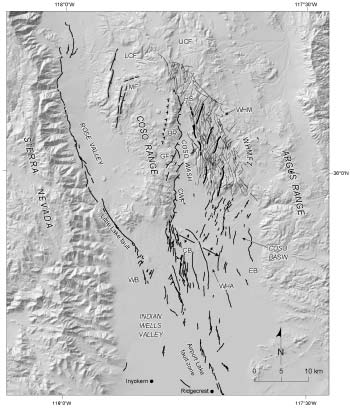The Nascent Coso Metamorphic Core Complex, East-Central California: Brittle Upper Plate Structure Revealed by Reflection Seismic Data

The relationships between upper crustal faults, the brittle-ductile transition zone, and underly-ing magmatic features imaged by multifold seismic reflection data are consistent with the hypothesis that the Coso geothermal field, which lies within an extensional step-over between dextral faults, is a young, actively developing metamorphic core complex. The reflection images were processed using a non-linear simulated annealing approach to invert P-wave first arrivals in the seismic data for 2-D velocity structure. Velocity tomograms obtained from the inversions were employed in a pre-stack Kirchhoff migration to produce depth-migrated images of subsurface structure. The seismic images reveal coherent reflectivity in the upper 5 km of the Mesozoic intrusive bedrock of the Coso Range. The Coso Wash fault and other late Pleistocene and Holocene normal faults in, and adjacent to, the geothermal field are expressed on the reflection images by lateral truncations of coherent reflectors, and locally as discontinuous planar reflectors down-dip of the surface fault traces. The faults appear to terminate downward against a faint, subhorizontal, discontinuous reflective horizon (“A”) at about 4 km depth that lies at or near the base of seismicity beneath the geothermal field. This horizon is interpreted to be the brittle-ductile transition zone. The seismic images also reveal a prominent high-amplitude reflector at 6 km depth directly beneath the geothermal field, and a deeper reflective horizon at a depth of about 8 to 9 km. These deeper reflectors are associated with a zone of low P- and S-wave velocities in the 6–12 km depth range beneath the geothermal field, and are probably related to the presence of magma or other pressurized fluids. The combination of magmatic heat and active normal faulting in the regional transtensional setting establishes the conditions for hydrothermal convection in the Coso geothermal field.
